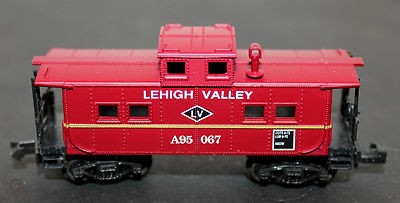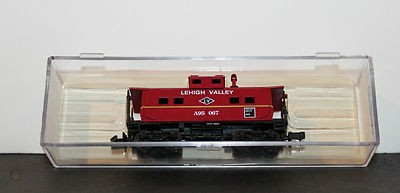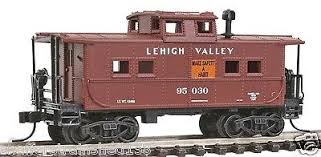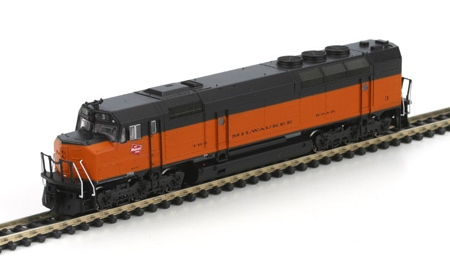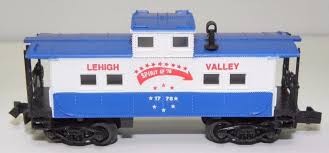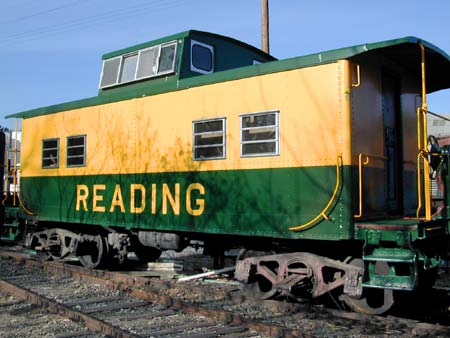Model Information: Life-Like first introduced this body style in the 90's. They have metal wheels and truck-mounted Rapido couplers. The caboose design is based on a common prototype used by many Northeastern roads.
Prototype History: The Northeast or NE style caboose was introduced by the Reading Railroad in 1924. The design was an all-steel version of a USRA design. The acquisition of these new cabooses was prompted by proposed Pennsylvania legislation requiring larger, more structurally sound caboose for use in through freight consists. The original set of cabooses was ordered from AC&F, but other manufacturers also adopted similar designs.
The Reading selection was made after the consideration of several designs. The original purchase was for 10 cars in 1924, but the design was so effective that it became the de-facto Reading standard and they continued purchasing new cabooses of this type through 1948. The design soon became popular with other Northeastern railroads such as the WM, L&NE, LV, CNJ and others.
The Reading selection was made after the consideration of several designs. The original purchase was for 10 cars in 1924, but the design was so effective that it became the de-facto Reading standard and they continued purchasing new cabooses of this type through 1948. The design soon became popular with other Northeastern railroads such as the WM, L&NE, LV, CNJ and others.
Road Name History:  The Lehigh Valley Railroad (reporting mark LV) was one of a number of railroads built in the northeastern United States primarily to haul anthracite coal. It was authorized April 21, 1846 in the U.S. state of Pennsylvania and incorporated/established on September 20, 1847 as the Delaware, Lehigh, Schuylkill and Susquehanna Railroad Company. On January 7, 1853, the name was changed to Lehigh Valley Railroad. It was sometimes known as the Route of the Black Diamond, named after the anthracite it transported. At the time, anthracite was transported by boat down the Lehigh River; the railroad was meant to be faster transportation. The railroad ended operations in 1976 and merged into Conrail that same year.
The Lehigh Valley Railroad (reporting mark LV) was one of a number of railroads built in the northeastern United States primarily to haul anthracite coal. It was authorized April 21, 1846 in the U.S. state of Pennsylvania and incorporated/established on September 20, 1847 as the Delaware, Lehigh, Schuylkill and Susquehanna Railroad Company. On January 7, 1853, the name was changed to Lehigh Valley Railroad. It was sometimes known as the Route of the Black Diamond, named after the anthracite it transported. At the time, anthracite was transported by boat down the Lehigh River; the railroad was meant to be faster transportation. The railroad ended operations in 1976 and merged into Conrail that same year.
During its existence, the Lehigh Valley Railroad used a rail line that later became known as the Lehigh Line in order for it to operate. The Lehigh Line was the railroad's first rail line constructed which was built in 1855 between Easton, Pennsylvania and Allentown, Pennsylvania and it served as the main line for the Lehigh Valley Railroad. Serving as the main line for the Lehigh Valley Railroad, the rail line expanded past Allentown to Buffalo, New York and past Easton to New York City, bringing the Lehigh Valley Railroad to these metro areas. During the early years, the line served as the body of the Lehigh Valley Railroad until the railroad either built more rail lines or railroads, acquired more rail lines or railroads, and merged other railroads into their system. The line was known as the Lehigh Valley Mainline during the majority of its time under the ownership of the Lehigh Valley Railroad, starting in the 1930s. The "Lehigh Valley" was absorbed along with several northeastern rail lines into Conrail; the main line became known as the Lehigh Line during the Conrail ownership. Conrail shortened the track miles by abandoning most of its route to Buffalo and some of the line entering New York City area. The Lehigh Line is now owned by the Norfolk Southern Railway.
As of 31 Dec 1925, 1363.7 miles of road, 3533.3 miles of track; as of 31 Dec 1970, 927 miles of road and 1963 miles of track.
From Wikipedia

During its existence, the Lehigh Valley Railroad used a rail line that later became known as the Lehigh Line in order for it to operate. The Lehigh Line was the railroad's first rail line constructed which was built in 1855 between Easton, Pennsylvania and Allentown, Pennsylvania and it served as the main line for the Lehigh Valley Railroad. Serving as the main line for the Lehigh Valley Railroad, the rail line expanded past Allentown to Buffalo, New York and past Easton to New York City, bringing the Lehigh Valley Railroad to these metro areas. During the early years, the line served as the body of the Lehigh Valley Railroad until the railroad either built more rail lines or railroads, acquired more rail lines or railroads, and merged other railroads into their system. The line was known as the Lehigh Valley Mainline during the majority of its time under the ownership of the Lehigh Valley Railroad, starting in the 1930s. The "Lehigh Valley" was absorbed along with several northeastern rail lines into Conrail; the main line became known as the Lehigh Line during the Conrail ownership. Conrail shortened the track miles by abandoning most of its route to Buffalo and some of the line entering New York City area. The Lehigh Line is now owned by the Norfolk Southern Railway.
As of 31 Dec 1925, 1363.7 miles of road, 3533.3 miles of track; as of 31 Dec 1970, 927 miles of road and 1963 miles of track.
From Wikipedia
Brand/Importer Information: Squeak N Products was started in 1989. The company specializes in N scale models and concentrates on Northeast roadnames, especially the "Squeak" or NYS & W.
Squeak N Products assigns an incremental stock number to its models, preceded by two letters representing the road letters. As a convention, in this database, we will use the number as the main stock number and will indicate the full stock number as secondary number.
Note: There was not a product #0013.
Squeak N Products assigns an incremental stock number to its models, preceded by two letters representing the road letters. As a convention, in this database, we will use the number as the main stock number and will indicate the full stock number as secondary number.
Note: There was not a product #0013.
Item created by: Alain LM on 2021-02-18 16:05:22
If you see errors or missing data in this entry, please feel free to log in and edit it. Anyone with a Gmail account can log in instantly.
If you see errors or missing data in this entry, please feel free to log in and edit it. Anyone with a Gmail account can log in instantly.


